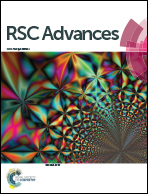Molybdenum disulfide composite materials with encapsulated copper nanoparticles as hydrogen evolution catalysts
Abstract
In the current work, a series of molybdenum disulfide composite MCNTs@Cu@MoS2 materials with high hydrogen evolution performance are prepared. In the hydrogen evolution reaction, their overpotential is as low as 225 mV at a current density of 10 mA cm−2 in 1 M H2SO4 as electrolyte solution. This excellent catalytic activity has been ascribed to its lower electrical impedance and high double layer capacitance. The encapsulation of copper nanoparticles into MoS2 crystals significantly reduces their resistance, enhancing the electron transfer rate during water electrolysis. Thereby, the introduction of conductive nanoparticles into semi-conductive catalyst crystals would be an efficient measure to improve their electrochemical catalytic activity in the hydrogen evolution reaction.



 Please wait while we load your content...
Please wait while we load your content...